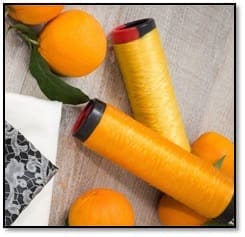It is truly said that nature has solution for everything. In fact, our clothes can be made out of some really amazing fabrics made from fruits you have been eating for so many years. The shell and peel which we often throw away can actually be turned into a perfect garment. Below are four such examples:
1.COCONUT:

Source: www.ecowatch.com
It is one of the most useful trees in the world, and is often referred to as the “tree of life”. It provides food, fuel, cosmetics, folk medicine and building materials, among many other uses. coconut fibre also known as coir, is a natural fibrous material found between the hard, internal shell and the outer coat of a coconut. Coir has known to be used in products such as floor mats, doormats, brushes and mattresses. But an excellent and eccentric use that has been seen as a Textile fibre. Globally around 650,000 tons are produced annually in 93 countries, with considerable motivation to expand production to further countries. 1000 coconuts provide a yield of 10kg of coir. Ithas one of the highest concentrations of lignin, which makes it significantly stronger than cotton. Resistant to microbial action. Highly durable and impressive absorbent. Dries fast, absorbs odour, stays cool and offers UV protection.
2. PINEAPPLE

Source: www.greenmatters.com/
The pineapple is a tropical plant with an edible fruit and in the 17th century it was a significant cultural icon of luxury. What makes it more luxurious is its fibre. The cultivation of pineapple is an archaic tradition and it was considered the fabric of queen of Philippine. The pineapple industry globally produces 40,000 tonnes of waste pineapple leaves each year, which are usually left to rot or are burned. Approximately 480 leaves (the waste from 16 pineapple plants) are needed to create 1 square metre of material. You must have also heard of “Pinatex”, made from cellulose fibres extracted from pineapple leaves, developed by Dr Carmen Hijosa. Pinatex is an alternative for natural leather and a perfect material for handbags as Pineapple fibres are very strong. Pineapple fabrics are mainly used for creating Barong Tagalog and other formal wear.
3. BANANA

Source: https://mavolu.com/
Bananas are a popular fruit consumed worldwide with a yearly production of over 165 million tonnes. Banana fibre harvested from the pseudo stems and leaves of the plant has been used for textiles in Asia since at least the 13th century. Both fruit-bearing and fibrous varieties of the banana plant have been used. n India, a banana fibre separator machine has been developed, which takes the agricultural waste of local banana harvests and extracts strands of the fibre. Surprisingly, Banana fibre is also used in the production of banana paper. Banana fabric is a beautiful and impersonates real silk. Fibre is generally extracted by a decorticator machine. It is a machine used to strip bark, skin, wood, stalk, and grain.
The extraction process is conducted as soon as the pseudo-stem’s leaves are cut. The common method in practice is a combination of water retting and scraping. It has low density, appropriate stiffness and Natural sorbent. Will keep you cool on hot days. It is grease-proof, water-, fire- and heat-resistant. Moreover, they are recyclable and biodegradable.
4. ORANGE

Source: http://orangefiber.it/
This citrus species can give you Silk-like fabric. This amazing discovery has stunned everyone. Orange Fibre is a textile made by extracting the cellulose from the fibres that are discarded from the industrial pressing and processing of the oranges. The fibre, through nanotechnology techniques, is also enriched with citrus fruit essential oil. The result is a vitaminic textile that nourish the skin like a not greasy body lotion. The orange-fibre yarn can be used for weaving any normal textile and can be mixed with other kinds of fibres such as linen and cotton. It is possible to dye or print with either ink-jet or natural pigment. It is a biodegradable fabric which feels soft, silky and lightweight.
Refrences:
- https://www.intechopen.com/books/banana-nutrition-function-and-processing-kinetics/banana-pseudo-stem-fiber-preparation-characteristics-and-applications
- https://www.sciencedirect.com/science/article/pii/B9781782421221500083
- https://www.the-sustainable-fashion-collective.com/2019/06/04/what-is-pineapple-fibre-and-how-do-you-make-textiles-from-it
- http://orangefiber.it/en/
- https://textilelearner.net/banana-fiber-properties-manufacturing/
By- Swati Singh

